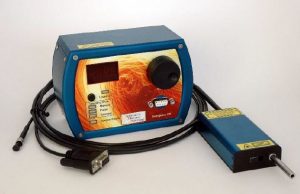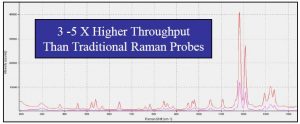
Brief Introduction to Raman Spectroscopy
Raman Spectroscopy is a vibrational spectroscopy technique unique from other vibrational spectroscopy techniques in that it can non-destructively measure samples in real time with no or very little sample prep. Additionally, because water has a very weak Raman signal, we can use Raman spectroscopy to analyze aqueous solutions. For these reasons, Raman spectroscopy is continuing to gain popularity in fields such as biomedical, pharmaceutical, defense and security, counterfeiting, and more.
The Raman Effect is commonly defined as the inelastic scattering of light by molecules because of the incident photon slams into the molecule, imparts or absorbs energy, then scatters off at a different angle. By collecting this scattered light and measuring the various shifts in wavelength caused by vibrations of the molecular bonds, one can determine the bond structure of the molecule by measuring the vibrations of molecular bonds. In order to measure Raman shifts, one must start out with highly monochromatic light (e.g. a laser) with very specific wavelength.
Choosing a Laser for Raman Spectroscopy
Choosing the correct laser is especially important for Raman spectroscopy compared with other spectroscopic techniques because the Raman shift is directly related to the light source and the measured spectroscopic data cannot be decoupled from the light source. The Raman Effect is a very weak effect and is directly proportional to the power of the light source.
The strength of the Raman signal is also tied to the specific wavelength used. Longer wavelengths give weaker Raman signal but have less (or no) fluorescence while shorter wavelengths give exponentially stronger Raman signal but may also have much higher fluorescence that can drown out the Raman signal. A Raman light source must also have narrow linewidth and very good wavelength stability and predictability as it must always be within the tolerances of the filters. See our new Lasers 101 page for more in depth information about the attributes of Lasers.
Today, diodes are the most popular choice for Raman excitation, but this was not always the case because traditional diode lasers have a high degree of uncertainty in their center wavelength are typically specified with a +/- 5 nm tolerance. In Raman spectroscopy, this is completely unacceptable as precise knowledge of the starting wavelength is required to accurately measure the shift in the energy of the scattered photon.
RPMC is able to offer a practical Raman source with a volume Bragg grating (VBG)-based hybrid external cavity diode laser (HECL) in both multimode and single mode with +/- 0.5 nm or +/- 0.1 nm wavelength tolerance and very narrow linewidth. These sources are available in a variety of wavelengths, output configurations, and packaging configurations.
Inventive Ways to Increase Raman Signal
Another important consideration when choosing equipment for a Raman experiment is the throughput of the collection system. Fiber-optic probes can be combined with an appropriate laser to collect Raman spectra in situations where free space access to the sample is unavailable. Traditional fiber-optic Raman probes have one fiber for delivering source power to the sample (typically with a 105 μm core diameter) and a second fiber for returning the Raman scattering back to the slit in the spectrometer. While there are applications in which this approach is advantageous, it suffers from higher coupling losses during excitation and collection compared with free-space Raman systems.
RPMC’s Integrated Raman Probe eliminates the excitation coupling loss by integrating the wavelength-stabilized diode laser into the probe head. In addition, coupling losses associated with the traditional 105 micron core round excitation fiber are eliminated by shaping the laser output into a collimated elliptical beam with an elliptical spot at the sample to maintain the étendue of the system since slit of the spectrometer is rectangular. This results in a throughput enhancement of 3 to 5X compared to traditional Raman probe designs in a modular Raman setup.
Contact us about your Raman Spectroscopy applications and we’ll be happy to help.

 SHIPS TODAY
SHIPS TODAY 